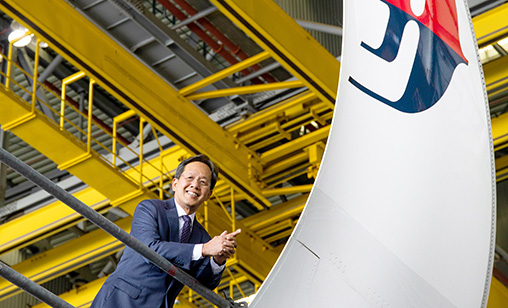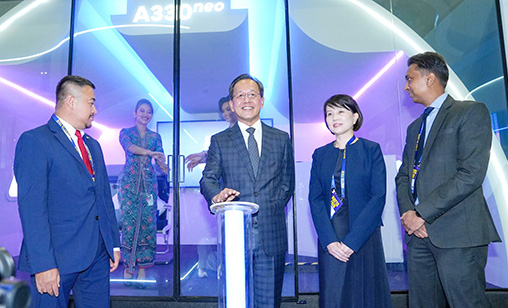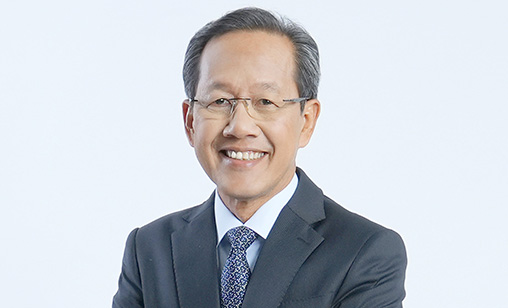Cover Story
Now or never pandemic moment transforms Malaysia’s flag carrier
After more than a decade of losses, Malaysia Airlines has a balance sheet in the black and a growth trajectory. The flag carrier is on a tear to catch up with its full-service peers and regain its position as one of the world’s best airlines. Associate editor and chief correspondent, Tom Ballantyne, reports.
April 1st 2024
It is ironic that COVID-19, the worst crisis in aviation history, turned out to be the savior of Malaysia Airlines. Read More » “Malaysia Airlines Group managing director and CEO, Captain Izham Ismail, told Orient Aviation last month. “I don’t deny that in the first weeks of the pandemic I lost all hope. Then I realized this was actually an opportunity for us,” he said.
With a debt-laden balance sheet, Malaysian Airlines had been battling for years to negotiate better contracts with individual creditors, some 75 of them, including aircraft lessors and OEMs. In mid-pandemic 2021, the airline negotiated, through a scheme of arrangement in a UK court, the gathering of all its creditors into one basket. With the support of major shareholder, Malaysia’ sovereign wealth fund Khazanah, and the Malaysian government, an agreement for a way forward for the airline group was reached.
 |
Today, that way forward is paying off. Izham and his team have hauled the airline back from the abyss. In 2023, MAG’s LCC Firefly, regional MASwings, engineering and cargo divisions, AeroDarat Services and an aviation training academy, recorded a positive operating profit for the second consecutive year of $186.4 million. It was a 64% improvement from $113.2 million in 2022. Cash balance stood at $900 million with no capital injections from main shareholder, Khazanah, since October 2021.
MAG recorded its first net profit after interest and tax in fiscal year 2023 of $160.6 million, a swing of $230 million from a negative $72.1 million the previous year. The airline division last reported a profit in 2010.
The shift in strategy, implemented by Izham and his team, has produced significant movement in the airline group’s sources of revenue. Historically, 55% of revenue generated by Malaysia Airlines (MAS) came from domestic operations and 45% from international travellers.
“Today, as I speak to you, close to 90% - yesterday’s number was 88% - was driven by international,” Izham said. “It shows we are encroaching into the market share of very strong premium airlines. It is actually a mammoth task for MAS to arrive at that space. We know it cannot be overnight. It requires a journey of resilience and ensuring we smartly invest in hardware products that enable us to compete.”
For the last two decades, MAS has been trying to find its footing, he said. “There were times we were going head on with low-cost carriers and there were times there was uncertainty about our business model and strategy. Was it moving forward?” he said.
“Most importantly, we had to acknowledge it was quite tough for us to move forward with the type of balance sheet we had.”
 |
But MAS has moved forward in several key areas. It stopped competing with LCCs and focused on premium travellers. It put effort into increasing international services. It thought outside the box when it came to paying its bills which, as a global company, mostly were written in U.S. dollars.
With a weak Ringgit, exchange rates were a problem. “By focusing on international flow and putting a lot of focus on our international points of sale, a natural hedge was created for our weak Ringgit. By October 2021, it actually benefitted itself. Everything fell into place at that time,” Izham said.
“We have generated positive cash flow since October 2021. Today, I would say, we have a comfortable cash balance that is more than 50% in US dollars. It means we don’t have to convert Ringgit to U.S. currency to pay our creditors. It’s a direct transaction and reduces financial pressure on us.”
Diversity is another key aspect of the airline group’s strategy. A lesson learnt from the pandemic was the group could not over-rely on the airline passenger business, Izham told Orient Aviation.
“By 2027, we aim to drive topline revenue from non-airline businesses by 30%,” Izham said. “Historically, we are doing 90% plus on airline revenue. So, we are diversifying more towards non-airline [businesses] like MRO, our [crew training] academy, our cargo business and so forth,” he said. Last year, non-passenger revenue contributed 22% to the group’s bottom line.
Introducing the latest generation aircraft into the fleet underpins the drive to be the best premium product for MAG customers. The group has 76 Airbus and Boeing jets with orders in place for 45 aircraft.
Current fleet composition is A330-200s (20), A330-300s (15), A350-700s (7), 737-800s (42), B737 MAX 8s (3) and three A330-200 freighters. It has ordered 20 A330-900s, three A350-900s and 22 737 MAX-8s. Malaysia Airlines subsidiaries, Firefly and MASwings, operate 17 ATR 72-500s and 72-600s. Some 90% of the MAS fleet is leased and all new planes will be on lease.
 |
| 'We are responsible enough to reroute our customers due to cancellation of flights and we will do that at a very advanced stage, not on the day of departure. The timeline we have established internally is seven days beforehand. We will decide [then] if an airplane is available or not. We give early warning to our customers' |
| Captain Izham Ismail MAG CEO |
Problems at Boeing have been an issue. The airline was expecting to accept 12 MAX-8s this year, but delays have reduced deliveries to eight of the type, Izham said.
“It is such a very unstable environment Boeing is facing today, but I am confident, to a certain extent, Boeing will put its act in order. We hope we will receive the airplanes. It is important, not only because of the hardware product, but because the MAX -8 promises more efficient fuel consumption,” he said.
If deliveries are pushed back again, the airline group has initiated a conversation with its B737 NG lessors to potentially extend leases to fill gaps, Izham said. In the meantime, enhancements are well underway on MAS’s existing fleet with 27 jets retrofitted with new seats.
More aircraft orders are on the cards. It has 20 lease options on A330neo. Izham said it is likely these options will be activated allowing for wide-body fleet growth. It also has issued a Request for Proposal for new narrow-body jets.
Izham is optimistic the airline group will be flying 50 narrow-bodies and 50 wide-bodies by 2033. “We are putting a lot of emphasis A330neo because our journey ahead is basically to focus a lot on the Asia-Pacific. We added new destinations last year and this year we are launching to certain points in India, Thailand and Maldives,” he said.
“The network expansion will continue more aggressively once we have the three additional A330 neos with us. New destinations in Europe are not being discounted, depending on market viability.”
Important pillars in the airline’s strategy are strengthening its position as the premium airline in Asia, that is to reinvent itself. And also having deep collaboration with partners, such as its recently announced partnership with IndiGo, India’s biggest airline.
“We don’t have 500 airplanes like IndiGo. We don’t have 1,000 airplanes like American Airlines. So partners are very important to us in taking our customers beyond the network Malaysia Airlines physically flies,” Izham said. “I am proud to share with you that Malaysia Airlines, with its partners, flies to nearly 1,100 destinations in 170 countries.”
India in particular is a very important market for MAS, Izham said. “IndiGo serves more than 100 airports in India. To us, a partner for domestic India is very important. Our offering to IndiGo is to strengthen its international Asia-Pacific network. It is a very good synergy we believe will benefit both organizations,” he said.
Izham has declared 2024 the “a year of building credibility” for MAS with its top priority being restoration of its reputation for premium service. The Long-Term Business Plan 2.0 (LTBP 2.0) has five main pillars: to become a premium Asia-Pacific carrier, to recapture its domestic and Asean markets, to drive deeper commercial partnerships, to diversify its revenue streams and make digital the cornerstone of its business.
 |
It has set out three customer value propositions (CVPs) to achieve by 2030. “The first of the three CVPs is cabin comfort, which comes with new airplanes. We will retrofit our older planes at new cabin standards to align with the new A330neos. We intend to do that with our fleet of seven A350s in 2025. If any of our passengers walk into the cabin of these aircraft, they will not notice the difference,” he said.
“The second CVP will address our cabin services. We must uphold customers as our centre of gravity and serve them with empathy.
“When we say ‘Malaysian Hospitality’, what does it actually mean? It is welcoming our passengers and staff as if we are welcoming them into our home. Not only in the cabin, but from the point of booking, shopping and the check-in counter. That is until customers arrive at their destinations. This starts from our staff and then to our suppliers, vendors and partners,” Izham said.
“The third CVP is enhancing customer experience through in-flight dining.”
Izham believes MAS has a responsibility as the national flag carrier to encourage tourism inflow into Malaysia. The airline has created products to attract travellers to stop over in Malaysia. “As an example, take a customer travelling from London to Sydney. Historically, these passengers are VFR (visiting friends and relatives) traffic with no desire to have a stop in Kuala Lumpur,” he said.
“So Malaysia Airlines introduced a bonus. For the same fare family you purchase for London to Sydney, we throw in a free ride for you, a side trip to Langkawi or Penang. Or another location, we also have partnered with a few hotels to offer as much as a 45% discount on accommodation. It induces tourism,” he said.
Digitalization is another critical area of development for MAG. “Digital is one of our key pillars. In the long-term business plan we rolled out in 2017 and improved in 2021, the fifth pillar is digital,” Izham said. It is vital to improving efficiency and speed of execution and it is a cornerstone of customer service. It contributes to a hassle-free travel experience, a hassle-free shopping experience and a hassle-free management of travel portfolios,” he said.
In the second half of this year, as part of MAG’s digitalization, MAS and Firefly will begin using an online chatbot, powered by AI (Artificial Intelligence), to respond to customer calls.
Question? What keeps Izham awake at night? Answer. Foreign exchange rates, the value of the Ringgit, interest rates and the price of fuel. But as MAG CEO, Izham is very confident about the airline’s commercial strategy.
“I am worried about macroeconomics driven by geopolitics. The reality is, as professionals we must embrace and accept that another pandemic is bound to happen. I believe very strongly we cannot discount there is high potential for more economic pressure or a disease related issue,” he said.
“With that in mind, MAS has to future-proof itself against any potential economic downturn driven by geopolitical conflicts such as what is happening in the Middle East. We have to brace ourselves.”
Whatever lies ahead, Izham said, MAS has established a pathway for moving forward in the next five to 10 years. “We want to be the most improved airline by 2025-2026. We want to be in the top ten league in the world by 2030. “We will put all our energy and focus on ensuring we deliver these positions,” he said.
Jenna leonard says:
May 29th 2024 08:41am